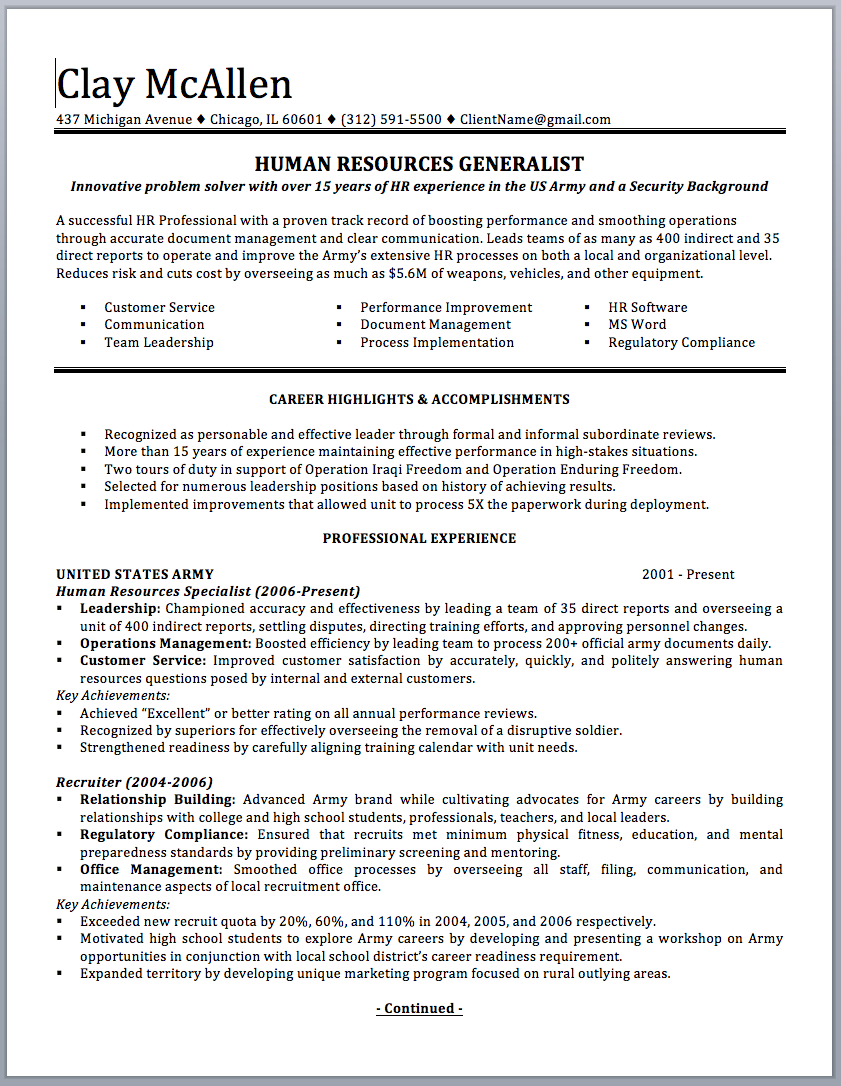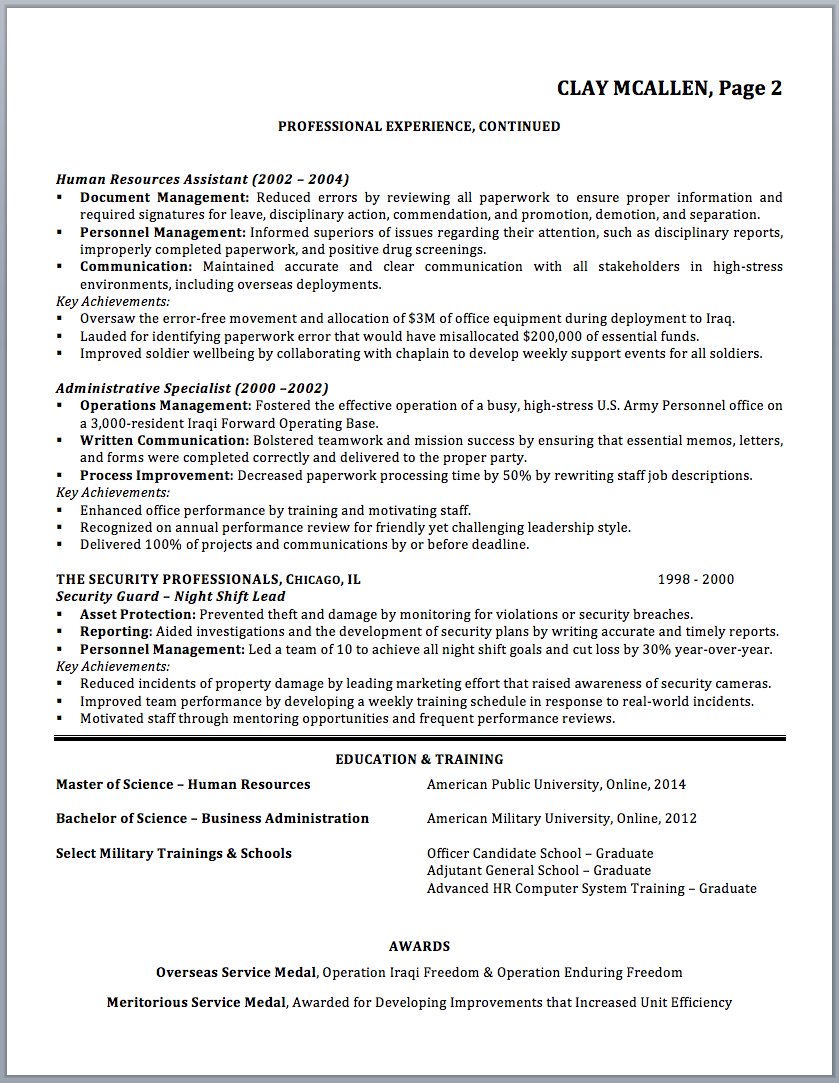Finding meaningful employment can be quite a daunting task for anyone separating from the military. Job-hunting can be challenging, but it doesn’t have to be a bad experience – remember, the valuable experience and skills learned during your term of service will have adequately equipped you for a successful career in the civilian world. With the right preparation and mindset, you can embark on your civilian life, confident and excited about the path that lies ahead. Following the advice in this article will make finding a job a breeze!
Below you’ll find a military to civilian resume, created by our professional resume writers to help you understand what you’re aiming for with the resume writing process. Before you begin writing your military to civilian resume, you’ll need to prepare properly – we outline this process in 3 easy steps!
Writing a Military to Civilian Resume Step 1: Choose an industry
First, you should decide what career path you want to take. Many military roles have a civilian counterpart, such as engineering, computing, communications, etc. If this isn’t the case for you, or you wish to pursue a new line of work, you should take time to consult those around you and decide your future path. Self assessment can often help provide guidance; ask yourself where your strengths lie and how these align with other important values such as what motivates you, and what you enjoy or feel passionate about. These factors may help identify the perfect career for you.
Professional help at hand also, for example the army have the Army Career and Alumni Program helping coach you through all the basics of job searching, teaching you how to network professionally, and give you access to specialist career councilors (here’s their soldiers for life FB page).
Writing a Military to Civilian Resume Step 2: Prepare the content
A good resume is one that effectively markets your work experience, skills and knowledge in a way that appeals to employers, and motivates them to give you a job interview.
A good resume is one that effectively markets your work experience, skills and knowledge in a way that appeals to employers, and motivates them to give you a job interview. So how do you achieve this? To begin the resume writing process I recommend getting all your thoughts down onto paper; this can then be organized and used to construct your new resume.
To start, get the DD Form 2586, “Verification of Military Experience and Training” (VMET) within 120 days before your separation. This document will provide a full overview of your skills and experience – you can read more about the VMET here. Use this document to determine your key experience and training/education, relevant to target industry. There are two types of skills you’ll want to showcase in your resume:
Active Skills – these are specific technical and tangible skills and abilities, for example personnel training, documentation management, software competencies, etc. for someone in HR.
Transferrable Skills – these refer to your broader skill set used across a range of jobs and include customer service, communication, leadership, etc.
After you’ve extracted what you need from the VMET, begin brainstorming any other skills and strengths you have – these can include less tangible qualities that can still be used to market yourself, like being a naturally very motivated person, for example.
Writing a Military to Civilian Resume Step 3: Build your resume
Resume writing can be tricky, especially when it comes to formatting and creating a neat, professional layout. You need to get the language and flow of the document just right also, to help engage the reader, until they give you an interview. RWD offer a specialist military resume writing service matching you with a certified resume writer who can take care of everything for you. If you’re happy to write your own resume, keep reading for essential guidelines and useful tips.
Resume Layout
You want the most important information to be read first. Try to include the most impressive information within the first 1-3rd of the document – this will help engage the reader.
Select specific sectioning that best presents your information. If you have education or have completed training that is key to the industry you’re targeting then put these in a section high up the resume. As you can see on the military to civilian resume example we provided, sections like “key skills” or “career highlights and accomplishments” are a great way to showcase impressive career information.
Content Selection & Language
Choose only the most important and impressive experience, skills and accomplishments to include in your resume. Keep it brief; you aren’t trying to land the job with your resume, only an interview. An interview will provide the opportunity to explain the content of your resume, so strategically include impressive background information, focusing on the results of your work.
Avoid including day-to-day responsibilities and duties, instead talk about your success.
Use civilian language and avoid abbreviations and technical military jargon. Simple easy-to-understand language is best on a resume, it will help with the flow of the document and also keep the reader engaged.
For a more in-depth explanation of resume writing, check out our CPRW certified resume writer explains resume writing page.
Styling
You want your military to civilian resume to look professional and eye-catching. There are a wide range of resume styling techniques you can employ to achieve this; Google search “resume samples” and check out what sort of styling elements you want to include. I recommend keeping it simple however, try to keep font size uniform across the document, and avoid the overuse of other styling elements such as bold text, color text, underlining, italicizing, etc.
5 Ways to Make Your Resume Great
- Resume formatting greatly influence your resume’s effectiveness. Consider whether you want to use a chronological, functional or combination resume format.
- Ensure all information is crafted to target the industry you want to work in. You can edit/update your resume for each job application you make to help achieve this.
- Quantify wherever possible; this means including numbers to help highlight important information. If you were a CO, include the number of people you lead (this can help highlight leadership and management skills). If you were in charge of budgeting, include the value of the budget. These numbers are eye-catching and help engage the reader. They are also a good way to identify the scope of your achievements.
- Keep it short – depending on your experience, one to two pages is the ideal length. Anything longer and there’s a chance the reader will be put off. Keep your font size between 10-14, leave out irrelevant information, and use bullet points to summarize experience.
- Review and check for errors – read the entire document backwards word by word to help spot easily overlooked typos that are sometimes missed by spellcheck. Have a friend read it over, they may see something you’ve missed.
Military to Civilian Resume
I hope you find this article useful – please like and share! If you’re writing your own military to civilian resume I recommend combining this advice with more specific instructions that can be found within the resume writing guide section of this website. Don’t forget, we offer a specialist military resume writing service and as a blog reader you can receive a 10 percent discount on your order with the code: blogreader. Feel free to call us for a free consultation today: 1866-706-0973. Best of luck 🙂



